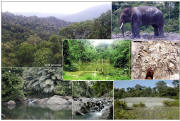ECOREGIONS REPRESENTED IN TABIN |
| The seven ecoregions of Borneo have been described in an excellent series of papers that Colby Loucks has prepared for the WWF WildWorld series (WWF & Loucks, C. 2001a-e). These are available online and are linked to a series of online overviews available at http://www.nationalgeographic.com/wildworld/. According to the scheme presented by WWF the island of Borneo can be divided into seven ecoregions as follows: |
 |
|
-
Borneo lowland rain forest (IM0102) – Predominant type in Tabin (see photo). Richest rain forests in the world. Rival the Amazon & New Guinea in biodiversity. Include almost 270 species of dipterocarp tree; 155 endemic to Borneo. Mostly cleared to make way for oil palm plantations. Predicted to be almost totally wiped out by 2012 except for forest & wildlife reserves like Tabin.
-
Borneo montane rain forest (IM0103) – Borderline montane forest found on the highest points of Tabin. Montane islands in the sea of lowland dipterocarp forest. Isolation produces unique & diverse suite of montane species. Of Borneo's endemic bird species 23 are montane. More than 150 mammal species. Most speciose montane rain forest found in the Indo-Pacific region.
-
Borneo peat swamp forest (IM0104) – Patches occur along the northern boundary of Tabin. Some of the most speciose peat swamp forests in the region. Key habitat for the endangered Borneo endemic proboscis monkey (Nasalis larvatus).
-
Southwest Borneo freshwater swamp forest (IM0153) – Does not occur in Tabin but thee are pockets if habitat in Tabin that have similar characteristics and support species such as macaques and orangutan.
-
Sundaland heath forest (IM0161) – Does not occur in Tabin. Kinabalu montane alpine meadows (IM1001) – Found in the vicinity of Mount Kinabalu. Not at Tabin.
-
Sunda shelf mangroves (IM1405) - Patches occur along the northern boundary of Tabin. Among the most biologically diverse mangroves in the world. Home to the proboscis monkey. Five major mangrove Characterised by Rhizophora-Bruguiera forests. Further inland there is display a greater species diversity. In areas with a substantial freshwater influence nipa palms dominate.
|
TABIN HABITATS |
| Tabin supports a wide variety of habitats and sub-habitats that comprise niches for the highly biodiverse flora and fauna that are a feature of the Reserve (click thumbnail right for photos of examples). Habitats can be viewed as niches within in the broad category of ecoregions. The range of habitats to be found in Tabin includes (but is certainly not limited to): |
 |
|
- Swamp forest & mangrove forest – mostly found along the northern fringes of the Reserve toward the Segama river. Home to species such as the proboscis monkey (Nasalis larvatus) and other primates. Populated by a characteristic suite of birds; many of them migratory. Also home to a wide variety of reptiles, amphibians and insects.
- Secondary forest – going through stages of succession after logging, road clearing or other forms of destruction such as fire (although fires are rare in Tabin). Rich in food plants that attract a host of grazing an browsing species and the animals that prey on them. Often with dense under brush.
- Primary forest (montane or lowland) – never logged. Found in Tabin’s Virgin Jungle Reserves. Forest floor fairly open. Home to hundreds of “climatic climax” species that can only survive in primary forest. The forest canopy is a whole world of its own with thousands of species virtually confined to canopy niches.
- Marsh land – in areas with standing fresh water that supports marsh plants. Especially rich in birds, amphibians, reptiles and insects.
- Flowing streams & freshwater pools – provide drinking water for larger species and a home for substantial populations of fish, amphibians and aquatic invertebrates. Pools provide bathing opportunities for elephants, humans and other mammals. Predators such as birds, macaques and monitor lizards are prominent along these water bodies.
- Caves – found along streams and on hillsides. Home to bats, swiftlets and other animals.
- Mud volcanoes – sources of salts and trace elements.
|